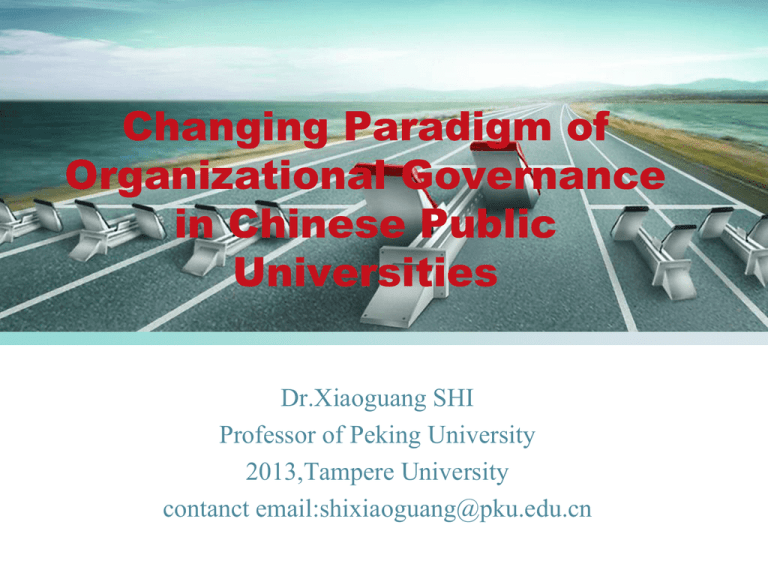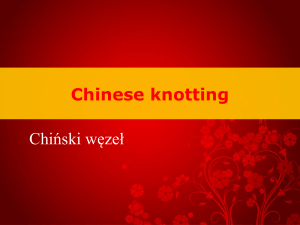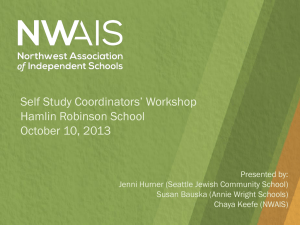Changing Paradigm of Organizational Governance in Chinese
advertisement

Changing Paradigm of Organizational Governance in Chinese Public Universities Dr.Xiaoguang SHI Professor of Peking University 2013,Tampere University contanct email:shixiaoguang@pku.edu.cn LOGO Outline • • • • Background:Changing Chinese Society University Governance Challenges and Realities UGC as Emerging Force in Institutional Structure. LOGO 1.Background: Changing Chinese Society LOGO China as a new emerging country • For the last three decades, China’ rapid growth of economy has created a miracle, it’s becoming the world’s second biggest economy in term of GDP per capita. • As observed by Sir John Bond, former group chairman, HSBC, “The timing does not matter, but we in the West do need to prepare ourselves, particularly our young people, for a powerful and exciting re-emergence of China on the world scene. The first of the ancient, historic powers [is] to return to glory. David Smith(2007) The Dragon and the Elephant :China ,India and the New World Order, Gopson Paers Ltd, p.94 LOGO 1-1.the Change of Economic System: • transfit from the planning economy to market economy, which, as a result, leads to other significant changes of the society. • ----the transformation of govermental roles. The policy making process is more decentralized. • ----transformation of Production Modes With the globalist knowledge economy stepping into China, enterprises have to turn from labor-intensive mode of production into the technology-intensive one. • ----the transformation of supply paradigm of labor market from govermental dominance to market force driven Please see next two slides(changes before and after 1992) LOGO The Old Centrally Planned Economy Model (befroe early 1990s) (quoted from Min's PPT) National Economic and Social Development Plan •--Human Resource developed and allocated according to the state plan •--Student trained as elements of production --- HE institutions were segmented and departmentalized Manpower Plan Higher Education Enrollment Plan however,the new model geared to market demands Curriculum and Instruction Plan --Human Resource developed and College Graduates Job Assignment Plan Graduate Entering Workplace allocated according to the labor market demand ---policy-making, very much decentralized ---Elimination of segmentation according to labor market demands. The New Market Oriented Economy Model (after 1990s) quoted from MIN Weifang (PPT) total State employment demand & Wage policy LABOR family benefit from HE income DEMAND FOR HIGH EDUCATION MARKET DEMAND expected Wage structure UNIVERSITES by education AND COLLEGES LABOR MARKET COLLEGE SUPPLY GRADUATES state allocation for higher education MACROECONOMIC SITUATION AND POLICIES Social and industry contribution LOGO • ---transformation of modes of social life. Globalization and Western living style influences to the young generation,eg.Coca-Cola is one of the most popular soft drinks. McDonald and Kentucky Fried Chicken are widely spread over China. Nike shoes and fashion blue jeans are new fashion. • ---Internet and Opening of Cultural Products Market. Hollywood movies, Korean pop singers, Japanese cartoons and game software are very popular among youngsters. LOGO 1-2.the changes of HEI system • ---.HEI system shifting from an elite mode of HEd to a mass one of that. public sector-- about 2,305 public universities and colleges, including 1,908 regular full-time HEIs,397 part time adult university ---740 ( 4y) ---1,168 (2-3y) ---413 (adult HEIs) private sector--1,521 new private institutions 297 (3-4y,degree granting institutions), 318 3-4y (independent colleges) 906 (non-degree awarding institutions). Differentiation by type and nature 2305 1908 4 397 Priority strategy for developing the leading universities There were 2305 regular Higher Education Institutions in 2009 “211” 1090 581 295 107 56 “985” 39 9 2 Peking Univ. Tsinghua Univ. Doctorate-granting universities Master’s universities 1215 Undergraduate universities Vocational or professional universities LOGO • ----transformation from central control to central coordination Several hundreds of HEIs affiliated to Central govermental agencies,such as MOE, has been transferred to the provincial governments.In the year 1996, 62 central ministries established 366 regular higher education institutions. In 2006, those managed by the central ministries and commissions amounted to 111, of which 73 were under the supervision of the Ministry of Education, and those at local level to 1,756. LOGO • ---HE nature shifting from public goods to semi-public goods,or PPP • ---Who beneifts , who will pay,no free higher education is provided in China. • ---public expenditure is not single resource to finally support the operation of HEIs The Characteristics of China's Higher Education Financing flow in a mixed economic period()Quoted from Min's PP National revenues Enterprises Household Savings Tax Income Transfer Capital Market Financial Interest Sharing Government Risk share Sharing Students Educational Bonds Stude nt Loans HEIs Loans HEIs Bond s Donations Tuition Fees Educational Recurrent Appropriation R&D Fundings Government Capital Appropriation Higher Education Institutions (HEIs) Special Grants (Note)Dotted line refer to those funding models which have not been initiated in China Commissioned Research LOGO • ---more institutional autonomy and academic freedom empowered to the HEIs As per the Law of Higher Education(1998), identities of HEIs are affirmed from a "governmentally affiliated" institutions to independent agencies as legal persons LOGO 2.University Governance LOGO 2-1.key terms defined University Governance--predominantly refers to the internal structure, organization and management of autonomous institutions.The organiztion of internal governance is generally composed of ---a governing board , the university president with a team of administrative chancellors and staff, faculty senates, academic deans, department chairs, and usually some form of organization for student representation. University governance: a changing conception..... Kezar and Eckel (2004: 371-398) point out the substance of governance has changed during the last decades with more emphasis put on high stake issues and more incremental decisions made in a less collegial mode. LOGO Dearlove (1997: 56-75) emphasizes that, • under the conditions of mass higher education, no university can avoid the need for some sort of bureaucratic management and organisation, though this does not mean that the importance of informal discipline and profession based authority (internal governance of universities) can totally be ignored. • With debates over the recent trends, university organizations, governing associations, and numerous postsecondary institutions themselves have set forth policy statements on governance. • Without exception, the university governance has been influenced by the international trends LOGO • In recent years, the discourse on the University Governance is attracting more attention in the Chinese academic communities as more and more university presidents, administrators and professors/ academics, as well as educationalists seem to be very passionate in exploring issues. LOGO First, the term “the University Governance” (“da xue zhi li” in PinYin) is a relatively new concept in Chinese context. It was seldom used before the end of 1990s.In other words, people would like to adopt the term “the university administration” (da xue xing zheng) or “the university management”(da xue guang li ) rather than “the university governance”. LOGO • Second, replacing University Administration by University Governance is clearly a consequence of influence from the idea of the New Public Managerialism, which represents an international trend of developmental future. • That is one of reasons why I would like to opt the topic for discussion with you today LOGO 2-1.key terms defined University leadership and management • Both "Leadership" and "Management" are important,but different too, as fuctioning differently in university governance procedure. • Leaders---persons who lead the way • Managers--persons who arrange the way Leadership & Management (Starratt, 2003) Leadership 24 Management Is concerned with growth Is a director Writes a script Based on moral authority Challenges people Has vision Exercises power of shared purpose Defines what is real as what is possible Motivates Inspires Illuminates Concerned with maintenance Is a stage manager Follows a script Loyalty & bureaucratic authority Keeps people happy Has lists, schedules, budgets Exercises power of sanctions & rewards Defines what is real as what is Controls Fixes Co-ordinates 24 Department of Educational Administration and Policy (http://www.fed.cuhk.edu.hk/eap/) in Chinese context: who is playing role of leadership? who is of management? why governance is introduced? 25 2-2.Modes of Leadership in Chinese HEI LOGO A Historical perspective ---the President Responsibility (1950-1958) ---the Limited University Governing Board Responsibility (1958-1960) ---the Amentment of the Limited University Governing Board Responsibility (1961-1966) ---the Exclusive Party Control System (1966-1977) ---the Multi-modes Co-existence System (1978-1998) ---The President Responsibility under Leadership of the Community Party Commision( CPC)or the Mode of CPC led President Responsibility(CPC Led PR) (1998- 2010) LOGO 2-3.Power Provision according Law on HE of 1998 the Law on Higher Education of 1998 states that, ---the CPC led PR is a mandatory mode of university governing and operation; ---the core value of university such as academic freedom and institutional autonomy came to be appreciated and guaranteed; ---the idea of operating universities by law has become a consensus so that lots of HEIs start to draft the University Charter, which is considered as a premise for creating a new type of organization structure of university governance. LOGO • --- CPC is paramount body of decisionmaking for the issue of strategic development in universities in a way of holding CPC meeting,such as approval of budget, relocation of campus, major construction plan, important promotion, crucial arrangement, and large scale investment so on and so forth. LOGO 2-4. Power Structure in General Bureaucratic +colleagial modes,very complicated and tricky • ----The CPPR & the CFSR (first tier), • The CPPR refers to the Conference of Communist Party Representatives, and the CFSR refers to the Conference of Faculty and Staff Representatives. • Those two conferences are the two most authoritative bodies, which can examine and approve the strategic plans for medium and long term development of higher education at public universities. • The CPPR and CFSR are usually held every five years so that they are not deemed as real administration agencies. LOGO • ---The Party Committee: University Decisionmaking Body (second tier) ---Menbership-- uncetain but standing member 9-12 including Party Secretary (1)and several vice secretaries(2) Standing Membership and Duty of the Party Committee Name &gender Post Concurrent Duty and obligation zhou P.S. Chair of UGC whole Partisan affairs, the P. C. ,and UGC affairs zhu .vice P S Pt whole executive affairs zhang vice P.S. vice Pt. ideological and moral education; student affair ,league system Yang vice P.S. Yu vice P.S. P.S. for D.C Party self-disciplinary & supervision Wu . Standing Vice Pt. Finance Ke Standing Vice Pt. Leading &Managing Medical Faculty Ao P. S. of MF managing Medical Faculty QU vice Pt. Logistic affair LI vice Pt. Int’l Affairs WANG standing vice Pt. Teaching affairs publicity, faculty trade union, the teachers’ representative council Note: P.S. = Party Secretary, Pt.=President; P.C=the Party Committee ;D.C=disciplinary Committee; MF=Medical Faculty which is emerged from Beijing Medical Univ. into PKU LOGO ---main tasks and duties: • to supervise and guarantee that the universities move forward in the right way; • to complete the publicity work, cooperation and coordination between the Communist Party and other minor Parties; • to take in charge of cadres (directors) appointment in the partisan system and beyond, • to prepare and recruit new party members; • to educate and train party members, • to guide and arrange the middle-level party chiefs of the sub-committee at the schools and departments to work. so on and so forth. LOGO --Operation as the policy-making body, PC has its own mechanism—the Party Commision Meeting (PCM) is held randomly. It will happen only when the university has some important events and needs a collective decision. PCM is a democratic mechanism of policy-making regarding to university affairs, particularly for important issues. On the meeting, Party Secretary is the chairperson who has right to propose the theme to discuss and decide, but he just has one vote equal to other members of the Party Committee LOGO Structure of party system Party Commision Managing group joint - conference sector for propergandizing branch of party at colleges sector for partician united work branch of party at colleges faculty union faculty union branch of party at colleges school for party member training branch of party at colleges LOGO ---Managing Group: University Executive body (second tier) • In the executive system, the MG is an executive team called as “xing zheng ban zi ”(Administrative Group). • Membership: 6--8 persons included • the President (1) and the vice presidents(5-6) , and one or several assistants to Pt • ---duties: • In daily operational work, President and the vice presidents have the right to decide those events in the sphere under their own guidance and supervision. LOGO ---operation: Usually, lots of regular decisions regarding managing universities are made by the President, vice presidents or through holding the President Administrative Group Meeting (PAGM). ---mechanism: PAGM is held weekly or monthly to discuss how to run the university and to improve its operation. PAGM have no membership limitation, but have core members which comprise of the president, vice presidents and relevant office directors at central administration of universities. Each time, different persons might be invited to participate in PAGM according to themes and contents. Apart from the core members, the people who will be involved with the contents of the meetings are invited to participate in PAGM. LOGO structure of administrative system Managing group Party Commision joint - conference office for traching colleges office for int'l affair office for reserch schools office for finance office for HR office for student affair LOGO • Other Academic organization: Limited Power Bodies • both universities and schools have established academically centralized unit—the University Academic Councils (UAC) equal to faculty Senate or UAC at Faculty or school level. • member: uncertain • One of the most important events that UAC are responsible for is to deal with academic title promotion every year. • Apart from UAC, there are some other academic committees.The academic committees are deemed as more and more important and necessary, but at present, UAC only plays a very limited role in managing university affairs.they are often called as vases academic organization system academic council (1979--), degree review commitee(1981--) teaching working committee(1993--) textbook construction committee(1986--) academic title promotion commitee(1981) student affair commitee(1987), ....... procedure of academic title promotion time :once, every year, from Apr. -Aug. open vacant posts (most time, HR staff,survey and consult with schools) application:providing CV and report of performance step:(1) review and discuss qualification of applicants among faculty senate or professorship (school level),and voting to recommend candidates for prof. or associate prof. posts; (2) oral defence before dicisplinary commitee(might be crossschools),voting to recommand to higher committee (3) oral defence (sometimes not necessary )before academic committee (university level), voting to ascertain who wins (4) approved by PAGM LOGO 3.Challenges and Realities LOGO • First, the contradiction between the political system and executive system is one of realities the over-emphasis on the role of party in managing university affairs might, to some extent, limit the free academic development and prosperity, particularly in humanist and social science, because the duty of the party system is to guarantee a mainstream ideological doctrine, such as “Marxist-Leninism”, “Mao Zedong Thought” , “ Deng Xiao Ping Theory” “Three Representatives” aw well as “the outlook of Scientific Development ” to control over political, moral education curricula in HEIs. LOGO • Second, over-centralized administrative power poses a big threat to Chinese HEIs. • both the Party Secretary and the President in a university are not elected by the faculty and staff of the university. Instead, they are usually appointed by the government agencies. LOGO • Third, the administrative power dominates the academic power which runs against inner logic of university governance. • the hierarchical control with the bureaucratic system gives more power to the administrative directors in deciding the university affairs. LOGO • most academics just become teaching or research machines rather than the owner of the HEIs. • Faculty/academics’ initiative and creativity are harmed and strangled. LOGO 4.UGC as Emerging Force in Institutional Structure. LOGO 4-1,Policy environment and reform background • • • • university governance council (UGC) a hot topic background:“the Tsien’ s Question” ”Why cannot Chinese HEIs produce world-class researchers?” • In 2005, Tsien Hsue Shen---the father of Chinese space technology expressed his concern in his dying time when Wen Jiabao-- Chinese premier went to visit him at hospital. LOGO • In 2009, MOE issued the “2020 Outline”, providing that HEIs are required to establish a new type of management mechanism and modern system of university by reforming and improving organizational governance of universities. In order to respond to the call of MOE, many people begin to consider how to conduct the reform. LOGO • Two tasks are considered necessary and significant. • One is to make University Governance Charter/regulation. • The other is that HEIs must make efforts to reform organizational governance structure by setting up UGC. LOGO International trend influence from traditional/dominate • --nationalism (affiliation) • --centralized • --public goods, govermental single input source; • --academical oriented • --teacher center model; • --internal supervision and evaluation to transitional/emerging • • • • • • • --corparation governance, marketization, managerialism --de-centralized,management by objective --P-P-P model,mixed input sources --vocationalism,market diven --academic community ,equal dialogue --student center, student consumerism, --external and internal evaluation LOGO Several new terms(ideas) accepted • • • • • • • Decentralization Accountability Assessment Strategic planning Privatization Branding Corporatization LOGO 4-2. Primary Exploration A matter of fact, the issue on the establishment of UGC is not new. In 1980s, Chinese academic community used to discuss about how to reform governance and leadership system by setting new operating mechanism. A few universities also have done lots of experimental work. • • • • • • such as: Shantou university, ( Guangdong,Li Ka Shing) Univerity of Science and Technology of China ,(Anhui) Northeast China Nomal University(Jilin) Central South China University(Hunan) Beijing Institute of Technology(Beijing) Fudan University(Shanghai) LOGO Shantou University case Located in south China’s Guangdong province, STU is one of provincial affiliated HEI established by Guang dong province government cooperating with Li Ka Shing Fund in 1981. Different from most public HEIs in China, STU has a very powerful new board of trustees. There are 25 board members, a financial advisor, a legal advisor and five special advisors. honorary chairman Li Ka Shing chairman governor of GD laymen PS of City LOGO mayor of city presidents coming from Mainland China ,Hongkang, Taiwan... adnimistrative representive president and PS form STU faculty representives two professors from STU HR advispr professor from Xiamen university financial advisor director Price Waterhouse Coopers in the Greater China area. special advisors(5) special advisor to the president of the university of Hong Kong former Chairperson of Peking University UGC former president of Peking University the deputy director, China Science Association and the former minister of education the former president , China Union Medical University LOGO 4-3. New Trends: • Recently, in order to respond to the 2020 Outline, some universities have set up or are scheduled to set UGC. There are two Models which can be observed LOGO Model-1 Strengthening Democratic Policy Decision • there are three different stories. • --- nothing has happened in some universities where the Party Committee has been given a new title; • ---something has been done in some universities where UGC which has been established basically on the prototype of the Party Committee, but it has absorbed several non-CCP Members to be involved, e.g. to invite them to attend PCM as a nonvoting delegate; • ---UGC established is basically based on both PCM and PAGM. All core members, even all members from both the Party Committee and the President Administrative Group become membership of UGC. • In this case the UGC becomes either an alias or camouflages of the Party Committee. LOGO Model-II. Establishment of Consultant Council • This model is quite similar to the pattern of STU, as mentioned above, where the UGC is not a decisive body but a consultancy one. The membership of UGC in this case, comprises of various sources. LOGO There are three groups of people involved: (a) parts of member of current Party Chiefs and executive chief, particularly current Party Secretary should be included and asked to act as Chairperson; (b) experts for administration and management. Most of them have rich working experience of leading or managing universities. Basically, they are former Party chiefs or executive chief of the universities; (c) some laymen and celebrities, including entrepreneurs, outstanding alumni, donators, student parent representatives, etc. LOGO 4-4. Summary • For the past three decades, the university governance has been changed in many aspects along with the socio-economic development. Old paradigm of institutional system, organizational, structure, and power distribution are either replaced by emerging one or improved to survive in the new environment. LOGO • First, in term of leadership system, the PRS under the leadership of the Party Committee has been institutionalized and legitimized as per the Law on Higher Education. The Party Committee is functioning similarly to that of Board of Trustee /Governing Board at corporate institutions. LOGO • Second, the academic force is getting enhanced along with the nature and innerlogic of universities being learnt and understood. The academic system comprising of the academic council as well as other expertise committees has been established and is playing an increasingly important role in operating university affairs, particularly with regard to those associated closely to academic issues and events. LOGO • Third, the UGC as a new emerging force is to become popular trends. Although it can’t sway the fundamental stone of conventional paradigm of university governance structure, it will helpful to improve current shortcoming of university governance in China. • How about the result? • We have to wait hopefully for something to happen as we expected LOGO Thanks for your attention and sincerely welcome to visit PKU---Peking University We look forward to your coming PKU campus tour as sightseeing will be one of your wise choices when you visit Beijing, More campus pictures could be foud if you aceess the webpaget at: http://english/ pku.edu.cn/ aboutpku/ virtualTour/





